A Scientific Guide to Writing Great Tweets: How To Get More Clicks, Retweets and Reach
Former Director of People @ Buffer
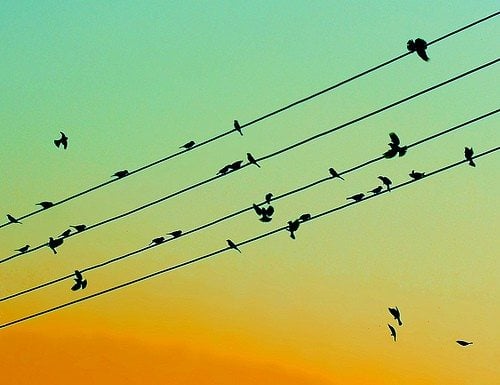
Last week Buffer had the great pleasure of co-hosting a webinar with Twitter (yes, THAT Twitter!)
During the webinar, I talked with Jimmy Hang of Twitter for Small Business about how to make your Twitter content work harder for your business, focusing on three major areas:
- Writing great tweets
- Timing it right
- Measuring and testing
If you weren’t able to make it but still want to write must-click content on Twitter (and really, who doesn’t?), here’s your guide! (Psst: You can scroll to the bottom to check out the slides or watch the entire video presentation).
What do people want from brands on Twitter?
According to Twitter, there are 255 million active Twitter users generating more than 500 million Tweets per day. Link clicks are by far the biggest way users interact with content, accounting for 92% of all user interaction with Tweets.
Twitter users follow a median of 6 brands on Twitter,
looking for things like interesting and fun content, news and updates, discounts and promos and more.So we know your customers are on Twitter, ready to click some links. They want to hear from you there and take actions that can benefit your business.
Twitter’s research shows that:
60% of respondents say they’ve made a purchase from an SMB based on something they saw on Twitter.
86% say they plan to purchase in the future.
43% of respondents plan to make multiple purchases from SMBs they follow on Twitter.

Writing great Tweets
Conversations that you have with your customers every day can also happen on Twitter. And you can approach these Twitter conversations the same way – like you’re talking to a good friend. Here are a few tips straight from Twitter:Know the difference between voice and tone.
Voice doesn’t change, but a business’ tone should vary based on a situation. If a follower did not have a positive experience, a business’ tone may be more sympathetic and understanding.Talk with people, not at them. Reply to @mentions and address both positive and negative feedback. It’s a real-time network, so businesses shouldn’t keep followers waiting too long.
Keep Tweets conversational. Be professional without being overly formal. Avoid business jargon when possible.
Think about how your content will be consumed by your followers. Would they want to retweet it or pass it along to others? Incorporate humor, inspiration and newsworthy content to draw followers in.
Here are some great, conversational examples from Twitter’s downloadable #MtgKickstart resource.
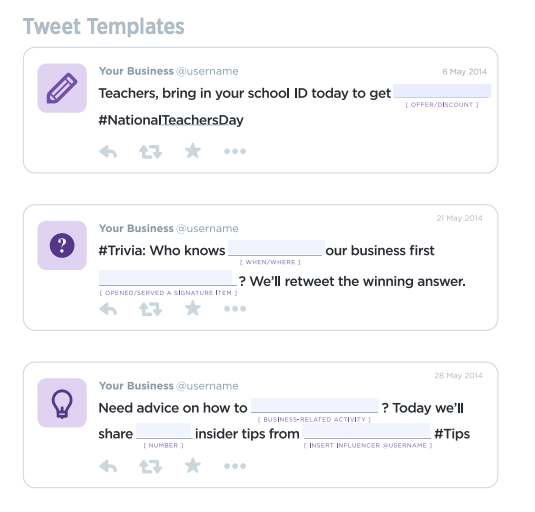
Viral words and phrases
Of course your own content, written in your brand’s voice, is the main idea to focus on for Twitter success.
But Twitter is particularly powerful at driving “amplification” for brand messages–retweets that share your message. In fact, 78% of user engagement with a brand’s Tweets is in the form of Retweets, according to Salesforce research.
So if you want a little help with that amplification potential, here’s a look at a few different studies on words and phrases that are most likely to help content spread.
Ripenn looked at the most viral words and phrases on four sites that focus specifically on viral content, including Upworthy and ViralNova. On these lists you’ll notice:
- Imperative words that tell you to do something, like see, make, look.
- Visual words like video and photos point to the importance of multimedia content.
- A lot of superlatives like “the most” and “the best” and “blow your mind.”
- Audience-referencing phrases like “make you,” “when you,” and “you see.” If you’re talking to “me,” I am more likely to feel strongly about the content.
- How-to phrases that explain a process or teach a skill.

Similar patterns appear here. Again, lots of audience-referencing, like “you,” and “Twitter,” another mention of “how to” and a lot of imperative words that tell you to do something, like retweet or share.
In fact, Salesforce found that tweets that specifically ask followers to “Retweet” receive 12X higher retweet rates than those that do not. When “Retweet” is spelled out, the retweet rate is 23X higher than the average. When using the shortened version, the letters “RT,” instead, the retweet rate is 10X higher.
Zarrella also found that tweets that contained more adverbs and verbs have a higher click-through rate than tweets with more nouns and adjectives. So the general rule that action words make for stronger, more compelling writing is also true for Tweets.
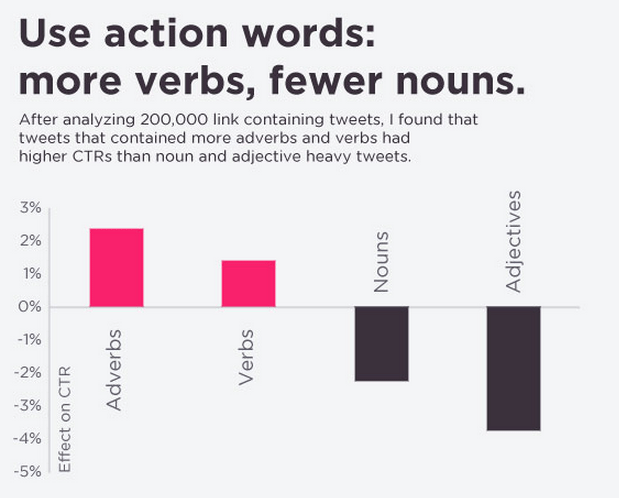
Formatting: Optimize for your goal
Different tweets can be used to achieve various marketing outcomes. For example, if you want to drive more direct response start by simplifying your Tweets.
Start with a compelling offer and then communicate a sense of urgency. Next, include a strong call-to-action with a link to your website. Finally, avoid using hashtags or @mentions.
Here’s the anatomy of a great “direct response” Tweet—you’ll notice that everything is focused on one goal: click the link.

This formatting can help set off content and signify that it’s something special that your followers will want to read and share.
Hashtags: How to choose the right ones
Consider creating a hashtag that is short, recognizable by followers, and allows them to easily follow along. If you’re using an existing hashtag, ensure you’re adding value to the conversation.
The volume of hashtags is important as well: one or two hashtags can get you up to two times more engagement than tweets without hashtags, according to a study by Buddy Media/Salesforce.

But when you use more than two hashtags, your engagement actually drops by an average of 17 percent. So make sure you’re choosing your hashtags carefully and focusing on the ones where you can add the most value for Twitter users.
Length: Around 100 characters is the sweet spot
While there may not be a foolproof “perfect length” for a Tweet, research by Track Social on 100 well-known brands popular on Twitter found that the sweet spot for Tweet length is right around 100 characters.Their analysis saw a spike in retweets among those in the 71-100 character range—the “medium” length tweets column in this chart.
This research makes sense when you consider how we use Twitter—a tweet at this length is long enough for the original poster to say something of value but still short enough for the person retweeting to add their commentary as well.
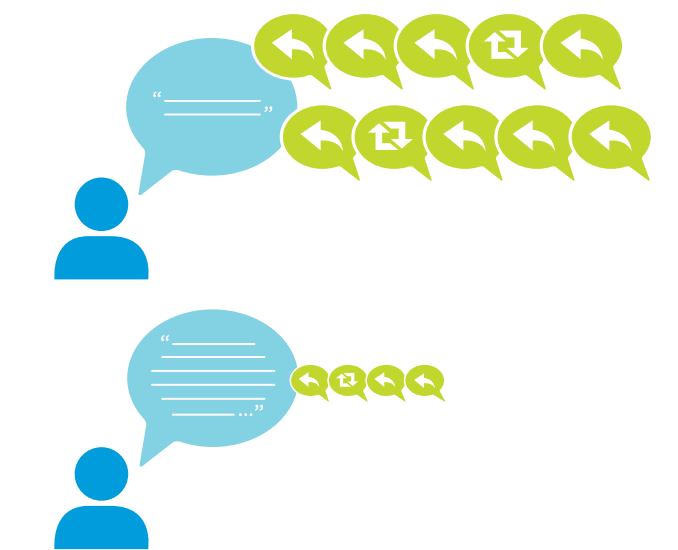
If you can veer toward the shorter side, it might be worth a try for your clicks as well. Tweets shorter than 100 characters get a 17% higher engagement rate, according to Salesforce.
Photos and video can make content twice as engaging
With Twitter, you have more than characters as content. Equip your marketing arsenal with rich media like photos and Vine or YouTube videos to drive retweets—it can double engagement with users.Late last year Buffer took a sample of 100 tweets from our own account and compared the engagement averages of tweets with and without images included using Buffer’s built-in analytics.The results? Tweets with images received 18% more click-throughs, 89% more favorites, and 150% more retweets.
Try a Twitter promotion for special content
Beyond your average Tweet, Twitter also offers a number of special promotion opportunities like these:
- Twixclusive: An exclusive offer on Twitter that your followers can’t find anywhere else. Use unique coupons to track your results and reward your customers. If you have a brick and mortar location, Tweet a discount code for customers to redeem at the register. For online stores, direct message followers with a discount code that you can track at checkout.
- Flock to Unlock: A concept to help incentivize followers to spread your message by retweeting (i.e. sharing) your Tweet to unlock exclusive content i.e. a sale, special product, an early release, etc.
- Lead Generation Card: These cards (which require you to add a few lines of code to your website) make it easy for potential customers to demonstrate interest in your business. When someone expands a Tweet that contains a Lead Generation Card, they will see a description of your offer. Then the user simply clicks once to securely share their contact information with you. Finally, easily download all the leads to use in your email marketing efforts. Here’s an example:
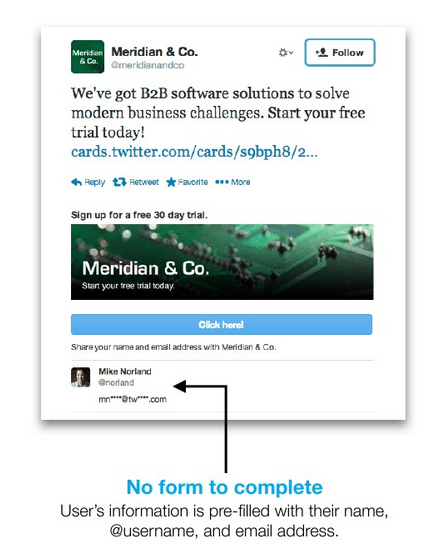
Timing it right
Try weekends for B2C, weekdays for B2B
Every business and audience is different, so it’s best to test multiple days of the week to see what works for you. If your brand speaks directly to consumers ,Saturdays and Sundays may have a higher engagement rate
as that is when most people are not at work and therefore have more free time.A study by Salesforce discovered that Twitter engagement for brands is 17% higher on Saturday and Sunday compared to weekdays, but that only 19% of all brand Tweets are published on weekends. Weekend engagement rates are particularly high for sports brands, fashion, entertainment and publishing brands.
And you don’t have to give up your weekend to take advantage of this–there are a lot of solutions like Buffer and others available that will schedule your tweets in advance (though you will want to keep an eye on your replies and participate in the conversation.)
For those working with business-to-business brands, you may want to stick with weekdays or start with a smaller experiment on weekends. An Argyle Social study says that weekdays provide 14% more engagement than weekends for B2B.
The best time of day to tweet: Daytime and afternoon
There is a 30% greater engagement rate when Tweets are published during the day (between 8AM-7PM). This makes sense if you consider the majority of news, store hours and activities happen during the day.
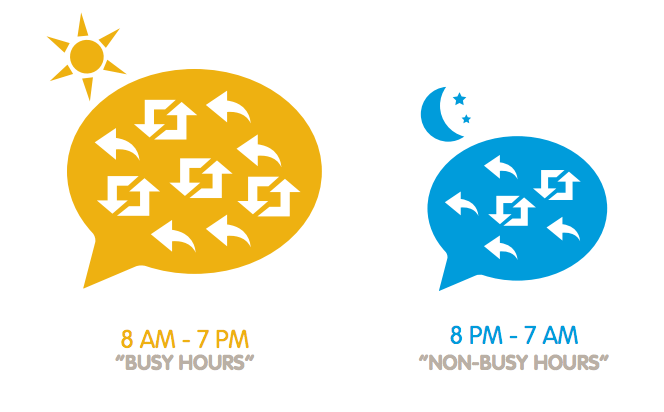
Specifically, the afternoon and early evening tend to be good time to see more engagement and clicks.
These stats from KISSMetrics say retweets have been shown to be highest around 5pm and that noon and 6pm are the best times to post for a higher clickthrough rate. (These findings are in the Eastern time zone, so adjust as needed for your location).
Another study on optimizing for clicks from bitl.y showed that 1–3pm is the best time to Tweet (once again, Eastern time zone).

Although some of the advice is conflicting, it all stays in the afternoon to early evening range, which may be worth a test for your brand.
Mobile users have their own patterns
There are also lots of Twitter users who primarily use a mobile device. These folks are very likely to be on Twitter during their commute as well as during school or work hours.
And these users just might be the ones you’re looking for for your business – they’re 44% more likely to click on links and 66% more likely to retweet than an average user. They also tend to follow more brands and they’re 53% more likely to recall seeing an ad on Twitter than the average Twitter user.
While all these different timing findings for different users can get complicated, the main idea is to put yourself in your followers’ shoes and consider the patterns of your own audience. What’s their day like? When are they busy? When are they bored? When do they have a few minutes between meetings? When are they most likely to want to hear from you?
If you want to know something a little more specific to your audience, you can also try a tool like Tweriod, SocialBro or Followerwonk that analyzes your account and gives you some key times to shoot for. You can then integrate those times right into your Buffer account.
Frequency of Tweets
More posts=more engagement
You’ll come across businesses that tweet 2x per day and others that post 20x per day. What’s most important is to develop a regular cadence of tweeting—your followers should know that they are going to get regular updates from you.
It’s generally OK to tweet as often as you have content to support it. Twitter is a high volume channel, and it helps to Tweet enough to get noticed in the stream.
Track Social studied 100 well-known brands that are active on Twitter and found that as brands tweet more, the total number of Retweets increases.
The general rule here: Make the most of the time you do have. If you’re a small business owner with a million things to do, you might be better off trying for 4-5 tweets per day to make the most of the time you do have. If you have the time and the content to post more often, Tweeting regularly helps you establish yourself as an authority on Twitter.
The more you tweet, the more opportunities you have to engage with fans, and the more total response you will receive. Greater volume should generally correlate to greater total response.
Try spacing out your links for more clicks
However, you might want to try to space your link posts out throughout the day. Social media scientist Dan Zarrella found that the higher the number of links an account Tweets in a given timeframe, the lower the click-through rate on each individual link.
To combat this potential effect, you might try experimenting with your posting rate by mixing up “conversation starter” tweets—where you ask question or post “inside scoop” type photos—with your more salesy posts with links so each link gets a little more attention.
A content calendar can help keep it together
Twitter often gets asked what small businesses should be tweeting about, so they put together a few content themes to help get the words flowing in this handy downloadable content calendar.
For example:
- On Monday, you could launch a Twitter-only promotion for your followers. Tweet an online offer code or a secret word for customers to use when they visit your business.
On Tuesday, tweet a behind-the-scenes tour of your business. Highlight how your products are made or where they are sourced from.
On Wednesday: Create a regular series of Tweets that are informative or surprising such as tips.
On Thursday, retweet a few positive customer reviews. Or tweet some industry-related news your followers might find interesting.
Finally on Fridays, give customers a glimpse into your workplace culture. Tweet photos or Vine videos of your colleagues and employees hard at work or having fun.
Measuring and testing
Metrics to explore: Growth, reach, engagement, clicks and conversions
Measuring your progress is key to growing your business on Twitter. Start by asking yourself what you want to achieve. From there, track your results on a weekly basis using a tool like Buffer. Here are a few key metrics worth a look:
Follower growth: How many new followers you get every day, week or month.
Follower quality and engagement: How many users interact with your account.
Reach: How many users favorite or retweet your Tweets.
Clicks: How many users click on your links.
Conversion: How many users sign up for your service or buy your product.
Testing: How to test headlines, hashtags and more
The more you tweet, the faster you will learn about what works and what doesn’t.
You can test different headlines, days and times, types of media and more to isolate what resonates most with your followers.
All you need is a way to track the metrics of all the Tweets you are sending. You can do this either through a URL shortener like bit.ly or with Buffer’s built in analytics.
For example, we test timing at Buffer by taking one piece of content and choosing 3-4 different times to test it on the same day. Buffer will always generate a different URL so it’s super simple to do a quick A/B test. It works best to keep the posts simple tweets with a headline plus a link each time (interspersed each time with other types of posts that are perhaps more conversational in tone).
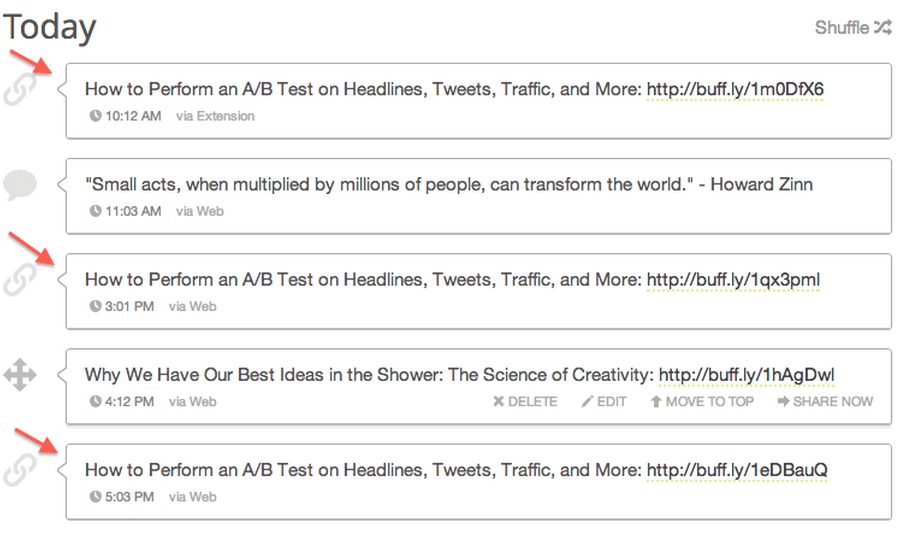
The following day, check your analytics and see how the tweets compare for clicks, favorites and retweets. From there, update your schedule to optimize for your metric of choice. Repeat this process as your content changes and you get more followers to make sure you’re always tweeting at the most optimal times.
You can also do this with headlines. At Buffer, we test headline variations by Tweeting out the article 3 or so times throughout a day with a different title each time. We track the results in Buffer analytics to see which headline performed best in terms of clicks, shares, and favorites. Then we re-write the post’s headline depending on the winner of the test.
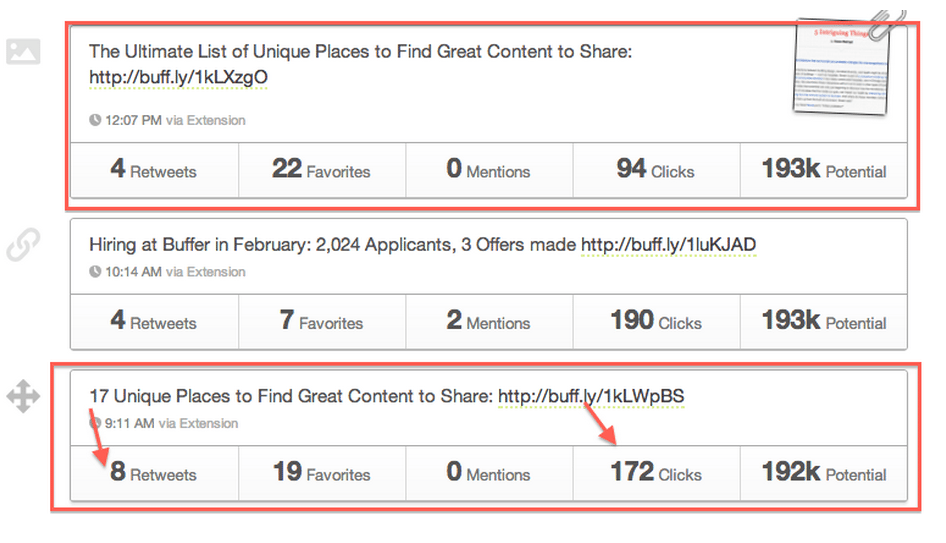
What “Twitter science” works best for you and your audience?
I’d love to hear what you’ve tested and how it went. Let me know in the comments. You can also check out the presentation slides or watch the webinar YouTube video below.
P.S. If you liked this post, you might also like The Twitter Strategy Guide: 14 Twitter Tips to Take Your Tweeting to the Next Level and Twitter Tips for Beginners: Everything I Wish I Knew About Twitter When I Started.
Image Credits: linh.ngan, Twitter, Dan Zarrella, Conductor, Salesforce, Track Social, Convince and Convert, KISSMetrics,
Try Buffer for free
140,000+ small businesses like yours use Buffer to build their brand on social media every month
Get started nowRelated Articles

This article looks into social media benchmarks for various industries and platforms.

This simple shortcut will help you cross-post and schedule posts to Bluesky with your iPhone.

What should I work on next? This is a thought that pops up many times throughout the day while I’m working as the Social Media Manager at Buffer. I’ll check Twitter/X, Instagram, LinkedIn, and Threads to make sure I’m covering all my bases and spending time in the best way possible. And on the good days, I’m right in the groove where I know exactly what to do next and what are the most important tasks that need to get done. What really helps me is making a checklist for my social media activi